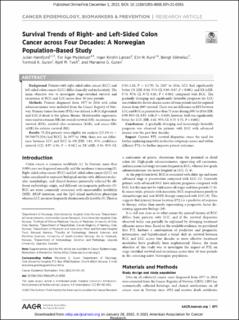| dc.contributor.author | Hamfjord, Julian | |
| dc.contributor.author | Myklebust, Tor Åge | |
| dc.contributor.author | Larsen, Inger Kristin | |
| dc.contributor.author | Kure, Elin H. | |
| dc.contributor.author | Glimelius, Bengt | |
| dc.contributor.author | Guren, Tormod Kyrre | |
| dc.contributor.author | Tveit, Magne Kjell | |
| dc.contributor.author | Guren, Marianne | |
| dc.date.accessioned | 2022-02-03T09:38:58Z | |
| dc.date.available | 2022-02-03T09:38:58Z | |
| dc.date.created | 2022-01-13T09:28:00Z | |
| dc.date.issued | 2021 | |
| dc.identifier.citation | Hamfjord, J., Myklebust, T. Å., Larsen, I. K., Kure, E. H., Glimelius, B., Guren, T. K., Tveit, K. M. & Guren, M. G. (2021). Survival Trends of Right- and Left-Sided Colon Cancer across Four Decades: A Norwegian Population-Based Study. Cancer Epidemiology, Biomarkers & Prevention. | en_US |
| dc.identifier.issn | 1055-9965 | |
| dc.identifier.uri | https://hdl.handle.net/11250/2976804 | |
| dc.description.abstract | Background: Patients with right-sided colon cancer (RCC) and left-sided colon cancer (LCC) differ clinically and molecularly. The main objective was to investigate stage-stratified survival and recurrence of RCC and LCC across four 10-year periods.
Methods: Patients diagnosed from 1977 to 2016 with colon adenocarcinoma were included from the Cancer Registry of Norway. Primary tumor location (PTL) was defined as RCC if proximal and LCC if distal to the splenic flexure. Multivariable regressions were used to estimate HRs for overall survival (OS), recurrence-free survival (RFS), survival after recurrence (SAR), and excess HRs (eHR) for relative survival (RS).
Results: 72,224 patients were eligible for analyses [55.1% (n = 39,769/72,224) had RCC]. In 1977 to 1986, there was no difference between LCC and RCC in OS [HR, 1.01; 95% confidence interval (CI), 0.97–1.06; P = 0.581] or RS (eHR, 0.96; 95% CI, 0.90–1.02; P = 0.179). In 2007 to 2016, LCC had significantly better OS (HR, 0.84; 95% CI, 0.80–0.87; P < 0.001) and RS (eHR, 0.76; 95% CI, 0.72–0.81; P < 0.001) compared with RCC. The gradually diverging and significantly favorable prognosis for LCC was evident for distant disease across all time periods and for regional disease from 2007 onward. There was no difference in RFS between LCC and RCC in patients less than 75 years during 2007 to 2016 (HR, 0.99; 95% CI, 0.91–1.08; P = 0.819); however, SAR was significantly better for LCC (HR, 0.61; 95% CI, 0.53–0.71; P < 0.001).
Conclusions: A gradually diverging and increasingly favorable prognosis was observed for patients with LCC with advanced disease over the past four decades.
Impact: Current PTL survival disparities stress the need for further exploring targetable molecular subgroups across and within different PTLs to further improve patient outcomes. | en_US |
| dc.language.iso | eng | en_US |
| dc.rights | Attribution-NonCommercial-NoDerivatives 4.0 Internasjonal | * |
| dc.rights.uri | http://creativecommons.org/licenses/by-nc-nd/4.0/deed.no | * |
| dc.title | Survival Trends of Right- and Left-Sided Colon Cancer across Four Decades: A Norwegian Population-Based Study | en_US |
| dc.type | Peer reviewed | en_US |
| dc.type | Journal article | en_US |
| dc.description.version | publishedVersion | en_US |
| dc.rights.holder | © 2021 The Authors; Published by the American Association for Cancer Research | en_US |
| dc.source.journal | Cancer Epidemiology, Biomarkers and Prevention | en_US |
| dc.identifier.doi | https://doi.org/10.1158/1055-9965.EPI-21-0555 | |
| dc.identifier.cristin | 1980102 | |
| cristin.ispublished | true | |
| cristin.fulltext | original | |
| cristin.qualitycode | 1 | |

